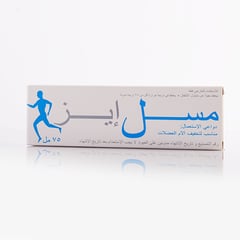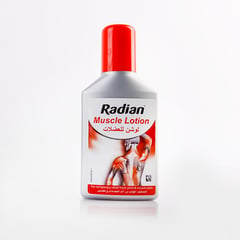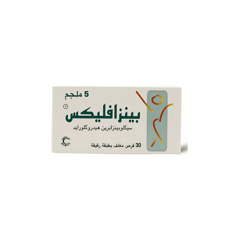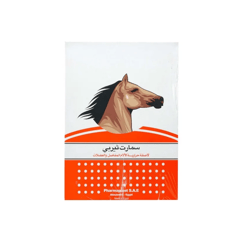Benzaflex 10 mg 30 Tablets

In stock
SKU :
1010-AR040
Benzaflex 10 mg Muscle spasms treatment, It works by helping to relax the muscles.
A valid prescription is a must for medicine dispense
What benzaflex 10 mg is used for:
- Benzaflex is a prescription medication used to relieve muscle spasms in the short term.
- It is typically used alongside rest and physical rehabilitation.
- It works by relaxing the muscles.
Do not use benzaflex 10 mg:
- Do not use benzaflex if you are allergic to it or have hyperthyroidism.
- During the acute recovery phase of a myocardial infarction and in individuals with irregular pulse, heart block, conduction abnormalities, or congestive heart failure.
Warnings and precautions of benzaflex 10 mg:
- Use only for brief periods of 2-3 weeks.
- Use with caution in urinary retention, narrow-angle glaucoma, intense outpatient programs, or concurrent use of other anticholinergic medications.
- May produce drowsiness/dizziness; do not consume alcohol or other central nervous system depressants as they may impair the ability to operate heavy machines.
- May take with food to avoid stomach distress.
- Serotonin syndrome has been reported when co-administered with other drugs that increase serotonin (for example, selective serotonin reuptake inhibitors, serotonin-norepinephrine reuptake inhibitors, tricyclic antidepressants, tramadol, bupropion, meperidine, verapamil, or anti-depressants).
- Not successful in treating spasticity associated with cerebral/spinal cord illness or pediatric cerebral palsy.
- Elderly patients may be more susceptible to side effects and require dose/frequency reductions.
- In hepatic impairment, use immediate release with caution; avoid the extended-release variant, which is not indicated.
Possible Side Effects of benzaflex 10 mg:
- Pounding heartbeat
- Confusion
- Drowsiness
- Xerostomia
- Constipation
- Dizziness
- Fatigue
- Hallucination
- Seizures
- Clumsiness or unsteadiness
Other Medicines and benzaflex 10 mg:
- If your doctor has prescribed this medication, your doctor or pharmacist may be aware of any potential drug interactions and is monitoring you for them.
- Before starting, stopping, or changing the dosage of any medication, consult your doctor, health care provider, or pharmacist.
- Severe interactions with benzaflex include:
- These medications include isocarboxazid, phenelzine, and tranylcypromine.
- Minor interactions with benzaflex include:
- Medications used include desipramine, dimenhydrinate, donepezil, eucalyptus, galantamine, sage, tacrine, and trazodone.
How to use benzaflex 10 mg:
- Adult: 5 mg orally every 8 hours; may be increased to 7.5-10 mg orally every 8 hours as needed.
- Geriatric: Start with an immediate-release tablet at 5 mg/day orally; gradually increase the dose and consider less frequent dosing.
Pregnancy & Breastfeeding Precautions While Taking benzaflex 10 mg Tablets:
- If you are pregnant or breastfeeding, suspect you are pregnant, or plan to have a baby, see your doctor or pharmacist before taking this medication.
- Your doctor will review the potential risks and advantages of using this medication during pregnancy and breastfeeding.
Non-Pharmacological Treatments & Advice To Reduce Pain:
- Massage.
- Acupuncture.
- Physical therapy.
- Biofeedback.
- Psychotherapy.
- TENS.
- Music therapy.
- Relaxation technique.
- Cognitive behavioral therapy.
- Exercise.
- Heat.
- Hypnosis.
- Yoga.
Storage Conditions Of benzaflex 10 mg Tablet:
- Store at 25°C.
- Keep away from children.
- Do not use this medicine after the expiry date shown on the carton label or blister strip.
- Store in the original package to protect from moisture.
| Shipping Type | Express |
|---|
Write Your Own Review
The largest selection of casino games and sports bets at 1xbet app.








